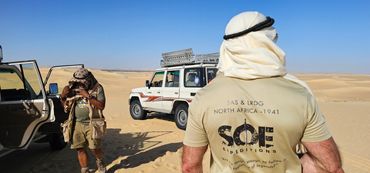Join us in October as we follow in the footsteps of the Special Air Service (SAS) and the Long Range Desert Group (LRDG) in North Africa - Egypt. Visiting WW2 battlefields and Egyptian historical sites of interest this is a once in a lifetime experience not to be missed.
Established in July 1941, the SAS was so named as part of a deception plan to convince the Axis that a full parachute regiment was in the region. Nonetheless, the SAS consisted initially of only 5 officers and 60 men. The SAS were trained as parachutists but the unit’s first drop behind enemy lines in November 1941 was a disaster, with one third of the unit killed or captured.
The SAS may well have been disbanded if it had not been for the successful raid on three German and Italian airfields, in which the LRDG provided the transport to the enemy bases. Approximately 60 enemy aircraft were destroyed with minimal loss to the SAS.
On an attack on Sirte, in December 1941, the SAS and LRDG developed a new attack technique: driving their trucks at speed between the rows of aircraft, riddling those planes with machine guns and flinging grenades. The success of this method made this the SAS’s preferred form of attack.
Formed in July 1940, by Major Ralph Bagnold, and originally called the Long Range Patrol, the LRDG grew and changed to its more well known name. One of the remarkable aspects of the LRDG is the enormous amount of time it spent behind enemy lines. It frequently operated from a base from Siwa Oasis in southern Egypt.
Join us as we visit some of these historic sites and follow in the footsteps of legends.














